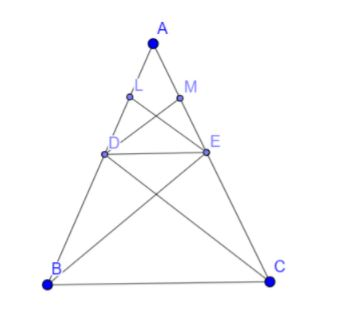
State BPT theorem and prove it.
Answer
526.7k+ views
Hint: To prove this theorem first we will join BE and CD. Then draw a line EL perpendicular to AB and line DM perpendicular to AC. Now we will find the ratio of area of \[\Delta \]ADE to \[\Delta \]DBE and ratio of area of \[\Delta \]ADE to \[\Delta \]ECD. Comparing the ratios we will get the final answer.

Complete step-by-step answer:
Now, \[\Delta DBE\] and \[\Delta ECD\] being on the same base DE and between the same parallels DE and BC, we have,\[ar(\Delta DBE)=ar(\Delta ECD)\] then we say that the basic proportionality theorem is proved.
Basic proportionality theorem:
If a line is drawn parallel to one side of a triangle to intersect the other two sides in distinct points then the other two sides are divided in the same ratio.
Given:
A \[\Delta ABC\]in which \[DE\parallel BC\]and DE intersects AB and AC at D and E respectively.
To prove that:
\[\dfrac{AD}{DB}=\dfrac{AE}{EC}\]
Construction:
Join BE and CD.
Draw \[EL\bot AB\]and \[DM\bot AC\]
Proof:
We have the
\[ar(\Delta ADE)=\dfrac{1}{2}\times AD\times EL\]
\[ar(\Delta DBE)=\dfrac{1}{2}\times DB\times EL\]
Therefore the ratio of these two is \[\dfrac{ar(\Delta ADE)}{ar(\Delta DBE)}=\dfrac{AD}{DB}\]. . . . . . . . . . . . . . (1)
Similarly,
\[ar(\Delta ADE)=ar(\Delta ADE)=\dfrac{1}{2}\times AE\times DM\]
\[ar(\Delta ECD)=\dfrac{1}{2}\times EC\times DM\]
Therefore the ratio of these two is \[\dfrac{ar(\Delta ADE)}{ar(\Delta ECD)}=\dfrac{AE}{EC}\]. . . . . . . . . . . .. . . (2)
Now, \[\Delta DBE\] and \[\Delta ECD\] being on the same base DE and between the same parallels DE and BC, we have,
\[ar(\Delta DBE)=ar(\Delta ECD)\]. . . . . . . . . . . (3)
From equations 1, 2, 3 we can conclude that
\[\dfrac{AD}{DB}=\dfrac{AE}{EC}\]
Hence we can say that the basic proportionality theorem is proved.
Note: The formula for area of the triangle is given by \[\dfrac{1}{2}\times b\times h\]where b, h are base and height respectively. If two triangles are on the same base and between the same parallels then the area of those two triangles are equal.

Complete step-by-step answer:
Now, \[\Delta DBE\] and \[\Delta ECD\] being on the same base DE and between the same parallels DE and BC, we have,\[ar(\Delta DBE)=ar(\Delta ECD)\] then we say that the basic proportionality theorem is proved.
Basic proportionality theorem:
If a line is drawn parallel to one side of a triangle to intersect the other two sides in distinct points then the other two sides are divided in the same ratio.
Given:
A \[\Delta ABC\]in which \[DE\parallel BC\]and DE intersects AB and AC at D and E respectively.
To prove that:
\[\dfrac{AD}{DB}=\dfrac{AE}{EC}\]
Construction:
Join BE and CD.
Draw \[EL\bot AB\]and \[DM\bot AC\]
Proof:
We have the
\[ar(\Delta ADE)=\dfrac{1}{2}\times AD\times EL\]
\[ar(\Delta DBE)=\dfrac{1}{2}\times DB\times EL\]
Therefore the ratio of these two is \[\dfrac{ar(\Delta ADE)}{ar(\Delta DBE)}=\dfrac{AD}{DB}\]. . . . . . . . . . . . . . (1)
Similarly,
\[ar(\Delta ADE)=ar(\Delta ADE)=\dfrac{1}{2}\times AE\times DM\]
\[ar(\Delta ECD)=\dfrac{1}{2}\times EC\times DM\]
Therefore the ratio of these two is \[\dfrac{ar(\Delta ADE)}{ar(\Delta ECD)}=\dfrac{AE}{EC}\]. . . . . . . . . . . .. . . (2)
Now, \[\Delta DBE\] and \[\Delta ECD\] being on the same base DE and between the same parallels DE and BC, we have,
\[ar(\Delta DBE)=ar(\Delta ECD)\]. . . . . . . . . . . (3)
From equations 1, 2, 3 we can conclude that
\[\dfrac{AD}{DB}=\dfrac{AE}{EC}\]
Hence we can say that the basic proportionality theorem is proved.
Note: The formula for area of the triangle is given by \[\dfrac{1}{2}\times b\times h\]where b, h are base and height respectively. If two triangles are on the same base and between the same parallels then the area of those two triangles are equal.
Recently Updated Pages
Master Class 12 Economics: Engaging Questions & Answers for Success

Master Class 12 Maths: Engaging Questions & Answers for Success

Master Class 12 Biology: Engaging Questions & Answers for Success

Master Class 12 Physics: Engaging Questions & Answers for Success

Master Class 8 Maths: Engaging Questions & Answers for Success

Class 8 Question and Answer - Your Ultimate Solutions Guide

Trending doubts
Why is there a time difference of about 5 hours between class 10 social science CBSE

Write a letter to the principal requesting him to grant class 10 english CBSE

What is the median of the first 10 natural numbers class 10 maths CBSE

The Equation xxx + 2 is Satisfied when x is Equal to Class 10 Maths

Which of the following does not have a fundamental class 10 physics CBSE

State and prove converse of BPT Basic Proportionality class 10 maths CBSE

Solve these important practice questions and improve your
understanding of this topic for FREE!
understanding of this topic for FREE!



